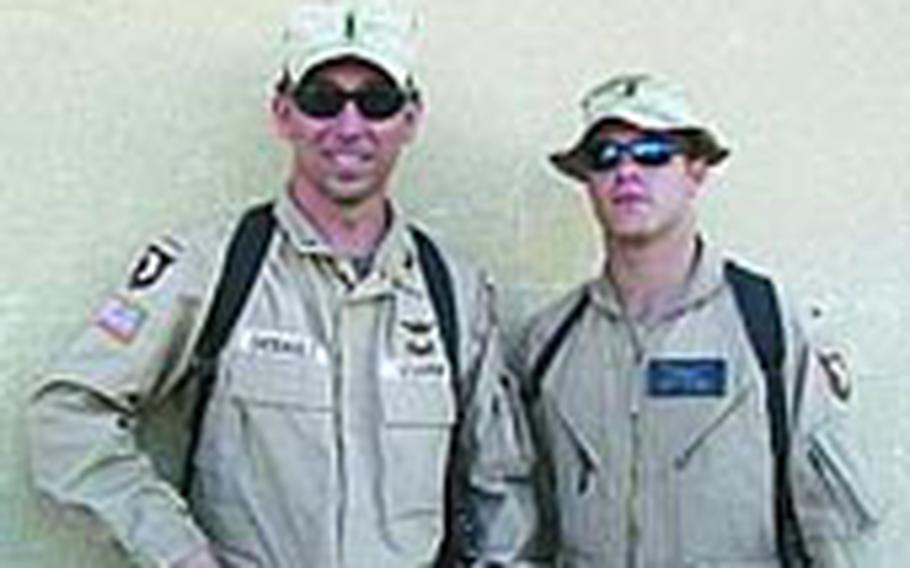
()
By the time Chief Warrant Officer 3 Richard Chenault and his Apache helicopter arrived, the patch of nowhere below him had already been hit hard.
Army Rangers and a host of others in a daring air assault had seen to it that the terrorist training camp in the remote western desert near Syria wouldn’t be doing much business.
The few enemies who remained on June 12, 2003, had little, but they did have the element of surprise — and it was enough to put up a fight.
Chenault, a veteran of Operation Anaconda in Afghanistan, and three other two-man Apache crews from the 3rd Battalion of the 101st Aviation Regiment were sent to fly security detail over the site.
It was a typically hot day, Chenault recalls, when the Apache crews saw a white pickup truck driving toward them in the dust below.
Eight men popped out of the truck and fired a volley of rocket-propelled grenades, striking the Apache flown by Chenault’s company commander.
The volley disabled the helicopter’s flight controls. The two-man crew crashed within 100 yards of the enemy fighters.
The grenades kept coming at Chenault, now the mission commander.
"At that point, you’re not thinking about you," Chenault said. "You’re worried about the two guys on the ground going through a little bit of suffering after getting shot down."
As long as the downed pilots were so close to the enemy, firing a Hellfire missile in their vicinity was risky.
Meanwhile, Chenault’s Apache got hit. He lost his utility hydraulics system and access to his 30 mm gun.
It got worse for his wingman. A round ripped through the armored plate of Chief Warrant Officer 2 Paul Larson’s seat and gashed open his back. They were 100 miles from base and they had minimal first aid.
"It wasn’t life-threatening, but in the air you don’t know exactly how bad he’s shot," Chenault said. "You just know he’s bleeding."
With three Apaches beaten up, the fight would go on for 20 minutes. Despite crippled weapons functions, Chenault and the other pilots seized the fight after the downed pilots made it clear of their helicopter.
"You do it like old-school Hueys and Cobra [helicopters]," Chenault said. "Put crosshairs on the windscreen and shoot the thing … and as you’re making your break, you have zero protection whatsoever."
Nevertheless, Chenault says he felt very prepared and comfortable shooting rockets that way.
The three helicopters’ tactics took out the enemy fighters. Ground soldiers brought back the downed pilots.
One of those pilots says he’ll forever be grateful to Chenault for his performance.
"CW4 Chenault is by far the most dedicated Warfighter that I have had the pleasure to work with in over 17 years of military service," wrote Maj. Michael Williams in an e-mail. "His unwavering commitment to his tactical and technical expertise is surpassed by none. If it were not for his valiant actions … I would not be here today to endorse his heroic deeds."
Chenault flew along with Larson to a hospital, where Larson would receive 38 stitches. Larson would get back in the air after a one-month recovery.
"The first thing when you see someone bleeding is, ‘Oh my God, what did we just go through?’ Then reality sets in," said Chenault, now Chief Warrant Officer 4 of headquarters company, 2nd Combat Aviation Brigade, 2nd Infantry Division at Camp Humphreys, South Korea.
"There we were again in another serious firefight … even though we were shot, we felt very fortunate that eight guys were still alive. Any time an airplane goes down, there’s a reasonable chance of losing somebody."
Chenault would face more firefights during his 12-month tour, but none as fierce as that day in June, he said.
Out of the 24 aircraft in Chenault’s unit, 22 came back from the deployment. Three pilots were wounded, but all survived.
Chief Warrant Officer 3 Richard Chenault
Unit: 3rd Battalion, 101st Aviation Regiment, 101st Airborne Division
Medal: Distinguished Flying Cross
Earned: Western Iraq, June 12, 2003
(Also earned the Bronze Star with Valor for an earlier action in Afghanistan)